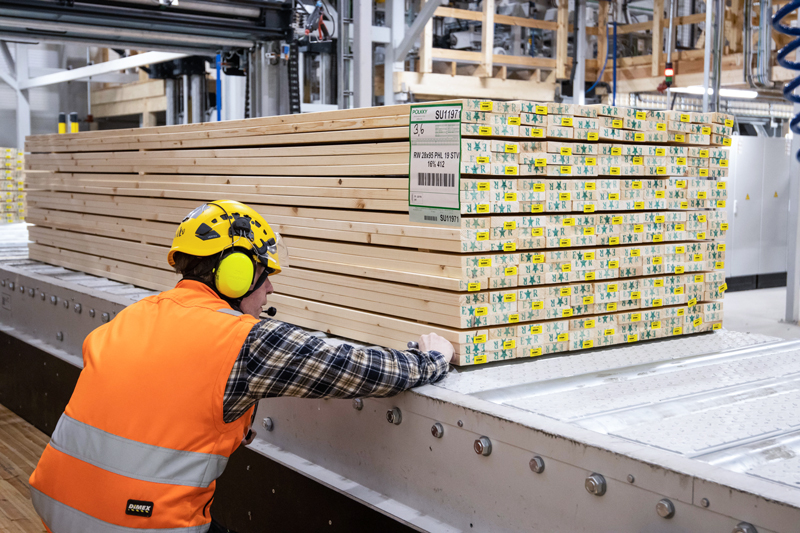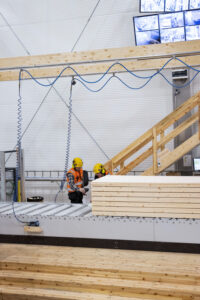
The journey of wood from the forest to a finished wood product can include many different steps. Previously, we wrote about the work of our wood procurement supervisor, how the first steps of a tree’s journey take place. This time we delve deeper into the different stages of wood production.

The wood raw material arrives at the production facility as a scheduled car transport either through our own procurement organization or through our suppliers. Reception scheduling is already planned in the forestry department, and it can be seen in the supply chain at the truck driver level thanks to modern planning software.
When the wood arrives at the production facility, it first goes to sorting and measuring, which is also used as a basis for payment to the forest owner and felling. Saw sorting and measurement is done with a Finnos meter that takes both X-rays and 3D imaging of the trees. The trees are sorted into logs according to their diameter, length and internal quality. This sorting serves customer needs at a later stage, in accordance with sales planning. Typically, the stock cycle in log sorting is about 2 weeks.
After the log sorting, the wood batches move to sawing, where the aim is to utilize the log raw material with the highest possible grade. Efficient production technology is used, in the renewal of which Pölkky has invested significantly in the last few years. For example, at the Pölkky Taivalkoski mill investments have been made to modernize sawmill production and increase capacity. The new Super planer is state-of-the-art and efficient, which can be used to make a wide variety of highly refined products for customers. At the Pölkky Kajaani mill, a significant modernization of production is also currently underway.
A number of different products are produced as sawn timber, e.g. the so-called heart material, i.e. planks and surface boards. The goal is to get the overall utilization ratio as high as possible in order to utilize the log raw material as precisely as possible. As a result of sawing, the sawn products are made into drying loads.
 Sawing also produces by-products such as sawdust, bark and wood chips. The sawdust and bark are used for energy production, which heats e.g. Pölkky’s drying kilns and other own facilities, and it is sold to other municipalities and cities for district heating production. The wood chips, on the other hand, are sold to the bioproduct industry as raw material for pulp.
Sawing also produces by-products such as sawdust, bark and wood chips. The sawdust and bark are used for energy production, which heats e.g. Pölkky’s drying kilns and other own facilities, and it is sold to other municipalities and cities for district heating production. The wood chips, on the other hand, are sold to the bioproduct industry as raw material for pulp.
After sawing, the sawn timber is transferred to a drying kiln, where the products are dried to the final moisture content according to the purpose, which varies between 10 % and 20 %. The drying process can be completed even in two days. Drying takes place with energy-efficient technology recovering waste heat.
The dried products go to quality sorting, where modern camera sorting technology is used. Quality sorting ensures the quality level according to our customers’ orders. After that, the products are packed for delivery to Pölkky’s further processing facilities or directly to customers. At this stage, part of the sawn timber is transferred to be forwarded to customers as is, e.g. for construction and as a raw material for industry, while some of the products go to further processing. At Pölkky’s further production facilities, wood is e.g. planed and impregnated, resulting in everything from frame structures to panels and laminated logs as well as pressure treated and glulam products.
The journey of the wood in production is less than a month long, typically 3–4 weeks, after which it is ready to be delivered to the customer. Which part of wood production interests you? Give us a tip, and we’ll write about it on our blog!

